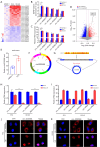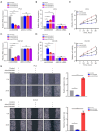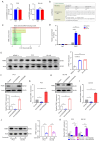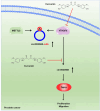Anti-cancer role of curcumin in prostate cancer cells via regulation of m6A-modified circ0030568-FMR1 signaling pathway
- PMID: 39698574
- PMCID: PMC11650353
- DOI: 10.21037/tau-24-276
Anti-cancer role of curcumin in prostate cancer cells via regulation of m6A-modified circ0030568-FMR1 signaling pathway
Abstract
Background: Prostate cancer (PCa) is the most prevalent adult malignancies worldwide and studies have shown that circular RNAs (circRNAs) play critical roles in the development and progression of PCa. As the most abundant modification, N6-methyladenosine (m6A) modification functions in regulating circRNAs expression and has been shown to regulate PCa progression. However, the biological relevance of m6A modification of circRNAs in PCa remains unclear. In addition, curcumin is reported to inhibit a variety of cancer cells while the biological functions in PCa have not yet been fully elucidated. Thus, our study aims to investigate whether curcumin can suppress PCa progression through the m6A-modified circRNAs.
Methods: By conducting m6A methylation immunoprecipitation combined with quantitative real-time polymerase chain reaction (MeRIP-qPCR) assay, cell counting kit-8 (CCK-8) assay and wound healing assay, increased m6A modification on circ0030568 was detected and upregulated circ0030568 was also observed in different PCa cells lines, which promotes proliferation and migration of PCa cells.
Results: More importantly, the results confirmed that curcumin could suppress the proliferation and migration of PCa cells lines by inhibiting METTL3-modified circ0030568. Mechanistically, m6A reader YTHDF2 elevated the stability of circ0030568 via m6A modification and curcumin could suppress PCa progression by inhibiting YTHDF2 mediated circ0030568 stability.
Conclusions: Taken together, circ0030568 may act as a promising biomarker and an attractive target for PCa treatment and curcumin's inhibition of m6A-modified circ0030568 may be a potential mechanism of its anti-PCa.
Keywords: Curcumin; FMR1; N6-methyladenosine (m6A); circ0030568; prostate cancer (PCa).
2024 AME Publishing Company. All rights reserved.
Conflict of interest statement
Conflicts of Interest: All authors have completed the ICMJE uniform disclosure form (available at https://tau.amegroups.com/article/view/10.21037/tau-24-276/coif). The authors have no conflicts of interest to declare.
Figures







Similar articles
-
M6A-modified circRBM33 promotes prostate cancer progression via PDHA1-mediated mitochondrial respiration regulation and presents a potential target for ARSI therapy.Int J Biol Sci. 2023 Mar 5;19(5):1543-1563. doi: 10.7150/ijbs.77133. eCollection 2023. Int J Biol Sci. 2023. PMID: 37056926 Free PMC article.
-
METTL3 facilitates prostate cancer progression via inducing HOXC6 m6A modification and stabilizing its expression through IGF2BP2-dependent mechanisms.Mol Cell Biochem. 2024 Jul;479(7):1707-1720. doi: 10.1007/s11010-024-05023-y. Epub 2024 May 31. Mol Cell Biochem. 2024. PMID: 38822192
-
YTHDF2 mediates the mRNA degradation of the tumor suppressors to induce AKT phosphorylation in N6-methyladenosine-dependent way in prostate cancer.Mol Cancer. 2020 Oct 29;19(1):152. doi: 10.1186/s12943-020-01267-6. Mol Cancer. 2020. PMID: 33121495 Free PMC article.
-
Recent advances in crosstalk between N6-methyladenosine (m6A) modification and circular RNAs in cancer.Mol Ther Nucleic Acids. 2022 Jan 21;27:947-955. doi: 10.1016/j.omtn.2022.01.013. eCollection 2022 Mar 8. Mol Ther Nucleic Acids. 2022. PMID: 35211355 Free PMC article. Review.
-
N6-Methyladenosine Modification Opens a New Chapter in Circular RNA Biology.Front Cell Dev Biol. 2021 Jul 23;9:709299. doi: 10.3389/fcell.2021.709299. eCollection 2021. Front Cell Dev Biol. 2021. PMID: 34368159 Free PMC article. Review.
Cited by
-
Antioxidant Senotherapy by Natural Compounds: A Beneficial Partner in Cancer Treatment.Antioxidants (Basel). 2025 Feb 10;14(2):199. doi: 10.3390/antiox14020199. Antioxidants (Basel). 2025. PMID: 40002385 Free PMC article. Review.
-
Multiple roles of circular RNAs in prostate cancer: from the biological basis to potential clinical applications.Eur J Med Res. 2025 Feb 27;30(1):140. doi: 10.1186/s40001-025-02382-0. Eur J Med Res. 2025. PMID: 40016786 Free PMC article. Review.
-
Cancer-specific Regulation of Metabolic and Epigenetic Pathways by Dietary Phytochemicals.Pharm Res. 2025 Aug;42(8):1443-1457. doi: 10.1007/s11095-025-03898-0. Epub 2025 Aug 4. Pharm Res. 2025. PMID: 40760406 Free PMC article. Review.
References
LinkOut - more resources
Full Text Sources
Research Materials
